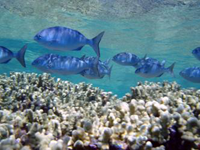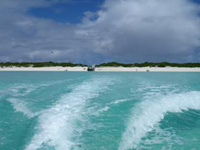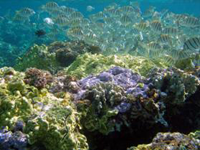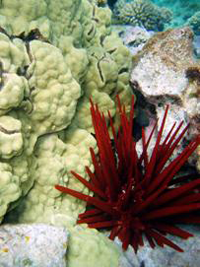- Heritage Home
- World Heritage Convention
- Japanese Midget Sub
- Papahānaumokuākea Marine National Monument
An official website of the United States government
Official websites use .gov
A .gov
website belongs to an official government organization in the United States.
Secure .gov websites use HTTPS
A lock (
) or https:// means you’ve safely connected to the .gov website. Share sensitive information only on official, secure websites..

On July 30, 2010, at its annual meeting in Brazil, the World Heritage Committee added the Papahānaumokuākea Marine National Monument in the Northwestern Hawaiian Islands to the prestigious United Nations Educational, Scientific and Cultural Organization (UNESCO) World Heritage List. The remote chain of atolls and surrounding waters is the first U.S. site to be added to the World Heritage list in 15 years and is the nation’s first site designated for its outstanding value as both a natural and cultural heritage site.
World Heritage Sites are of such international significance that, once UNESCO designates them, the nations that manage them promise the world that they will preserve them for present and future generations. There are cultural and natural heritage sites that are as unique and diverse as the wilds of East Africa’s Serengeti, the Pyramids of Egypt, the Great Barrier Reef in Australia and the Baroque Cathedrals of Latin America. The United States was the prime architect of the World Heritage concept and the first country to ratify the World Heritage Convention, in 1973. The National Park Service manages all or parts of 17 of the 20 existing U.S. World Heritage Sites, including Yellowstone National Park, the Grand Canyon, and the Statute of Liberty, and serves as the principal technical agency for the U.S. Government to the World Heritage Convention.
On January 15, 2009, the U.S., through the Departments of State and Interior, submitted to UNESCO its nomination of the Papahānaumokuākea Marine National Monument for inscription on the World Heritage List. The application was determined to be complete in March 2009, meaning all of the technical requirements of the World Heritage Committee’s Operational Guidelines offsite link had been met. The nomination was then submitted to the appropriate Advisory Bodies for evaluation: the International Council on Monuments and Sites (ICOMOS) for evaluation of the cultural heritage component, and the International Union for Conservation (IUCN) for evaluation of the natural heritage component.
To be included on the World Heritage List, sites must be of outstanding universal value and meet at least one out of ten selection criteria offsite link. In early June 2010, after conducting extensive consultations in Hawaii to evaluate the nomination, both ICOMOS and IUCN recommended that the Papahānaumokuākea Marine National Monument be inscribed on the World Heritage List. ICOMOS reported that the Monument satisfied two cultural heritage criteria while IUCN reported that the Monument satisfied three natural heritage criteria. Therefore, the Advisory Bodies determined that the Papahānaumokuākea Marine National Monument not only satisfied the minimum requirement of one selection criteria, but rather met five of the possible ten criteria.
The World Heritage Committee made the final decision to add the Papahānaumokuākea Marine National Monument to the World Heritage List on July 30, 2010 when the intergovernmental World Heritage Committee met in Brazil. In a press release, Dr. Lubchenco, the Under Secretary of Commerce for Oceans and Atmosphere and NOAA Administrator, recognized that "[a]s the nation’s first primarily marine World Heritage Site, Papahānaumokuākea helps forward global recognition of the critical heritage values of the sea and global understanding of the importance of protecting our oceans."

Additional reference information: ![]()

On April 3, 2008, the Papahānaumokuākea Marine National Monument, an area that includes the Northwestern Hawaiian Islands, received final designation as a Particularly Sensitive Sea Area (PSSA) by the International Maritime Organization (IMO), a Specialized Agency of the United Nations. The U.S. proposal for PSSA designation was submitted in April 2007 for consideration by the IMO's Marine Environment Protection Committee and received provisional "in principle" designation in July 2007. With the April 3, 2008 final designation the PSSA became immediately effective. The Papahānaumokuākea Marine National Monument is the second marine protected area in the United States to receive PSSA designation (the other being the Florida Keys National Marine Sanctuary, which was designated as a PSSA in 2002). PSSA designation has been granted to 11 areas globally, including the Great Barrier Reef and the Galapagos Archipelago. The newly designated PSSA is coterminous with the Papahānaumokuākea Marine National Monument, which was established by President Bush in June 2006. It encompasses a 1,200-mile stretch of coral islands, seamounts, banks, and shoals; is home to more than 7,000 marine species; and contains 4,500 square miles of coral reefs.
Ship traffic has been identified as one of the primary anthropogenic threats to the vulnerable and valuable natural and cultural resources of the area. PSSA designation augments domestic protective measures by alerting international mariners to exercise extreme caution when navigating through the area.
As part of the PSSA designation process, on October 8, 2007 the IMO's Maritime Safety Committee adopted U.S. proposals for two associated protective measures designed to prevent damage to this fragile and integrated coral reef ecosystem from international shipping activities. First, the IMO approved the expansion and amendment of the six existing recommendatory Areas to be Avoided (ATBAs) in the area, enlarging the class of vessels to which they apply and augmenting the geographic scope of these areas as well as adding new ATBAs around Kure and Midway atolls. The ATBAs will appear on domestic and international nautical charts to direct vessels away from coral reefs, shipwrecks and other ecologically sensitive or culturally significant areas in the PSSA that may also be hazardous to navigation. Second, the IMO approved a ship reporting system for vessels transiting the Monument, which is mandatory for ships entering or departing a U.S. port or place and recommendatory for other ships. The ship reporting system will provide critical alerts and other information to assist mariners in navigating safely through the area. The final rule implementing the IMO-adopted ship reporting system was published by NOAA and the U.S. Fish and Wildlife Service on December 3, 2008 (73 Fed. Reg. 73592), effective January 2, 2009.
NOAA's Office of General Counsel for International Law was instrumental in developing the United States' PSSA submissions and securing their approval by IMO.
Additional reference information: ![]()

Papahānaumokuākea Marine National Monument home page
Frequently Asked Questions about the World Heritage Nomination